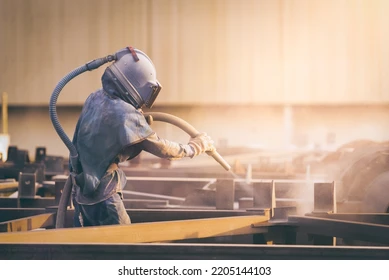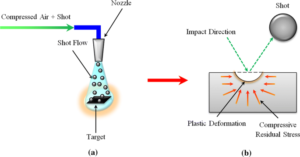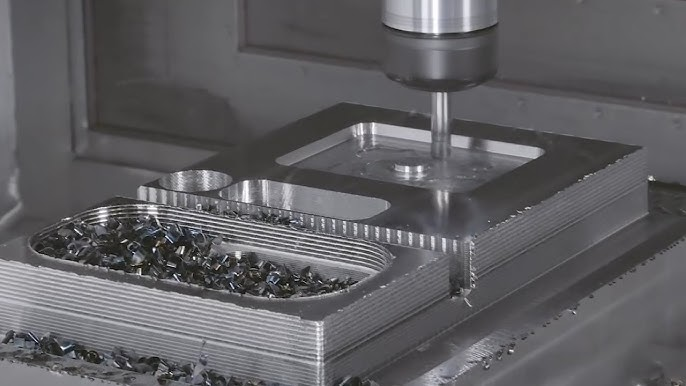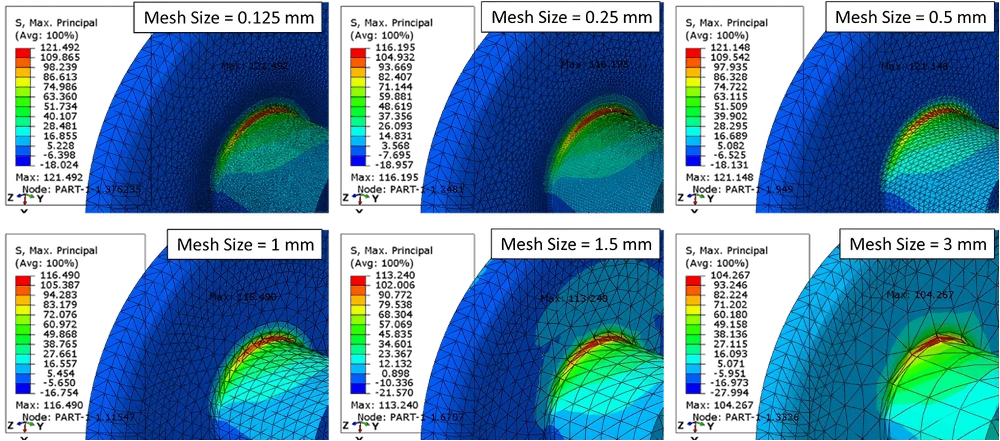How do industries ensure that metal parts are resilient to wear and tear, don't corrode, or function better over time? What methods are applied to surfaces to prepare them for coatings, polishing, or structural improvement? In post-processing shot peening and sandblasting are two widely used but frequently misunderstood procedures that are essential to accomplishing these objectives. Then why are they so important in sectors like aerospace and automotive manufacturing, and what makes them unique?
While sandblasting is commonly used for surface preparation and cleaning, shot peening, which is known to increase fatigue strength by creating compressive stresses, and sandblasting may appear similar, they have quite different functions. This article will explain the facts underlying these methods, look at their unique benefits, and investigate the applications and reasons for use.

2. The Role of Surface Treatment in Vacuum Chambers
The durability and performance of vacuum chambers in post-processing are significantly influenced by surface treatment. Since these chambers are intended to maintain extremely low pressures, the inside walls' surface quality is crucial. Any surface flaws, impurities, or irregularities can introduce undesired outgassing, which raises internal pressure that contaminates the vacuum environment and has a substantial influence on performance.
Several surface treatments are frequently applied to enhance vacuum chamber performance:
- Polishing: This procedure reduces impurities and trapped gas molecules by assisting in the creation of a flawless, smooth surface. A polished surface also minimizes the possibility of particle shedding, a typical concern in high-vacuum applications.
- Sand Blasting/Shot Peening: To prepare the surface for a subsequent coating, mechanical surface treatments like shot peening and sandblasting can assist in cleaning and roughening the surface. Roughened surfaces could be preferable in some situations to improve coating or plating adhesion.
- Electropolishing: This advanced technique leaves a very smooth and clean surface by eliminating minute surface imperfections. This treatment works very well to improve corrosion resistance, and cleanliness, and reduce surface roughness.
- Coating and plating: You can enhance a surface's chemical inertness, corrosion resistance, and thermal stability by applying specialized coatings or plating it with materials like gold, nickel, or chromium. Additionally, these coatings stop gases from seeping into the chamber walls.
- Chemical Polishing: In addition to physical polishing and electropolishing, there is also chemical polishing, sometimes referred to as chemical finishing or chemical smoothing, which is a surface treatment method that improves a material's surface qualities and appearance through chemical processes. It is frequently used to create a smooth, glossy, and corrosion-resistant surface finish in a variety of industries, such as electronics, plastics, and metal manufacturing.
3. Shot Peening in Vacuum Chamber Post-Processing
Vacuum chambers can be post-processed to improve their surface qualities by using a mechanical procedure called shot peening. This is a cold working technique in which high-velocity small, spherical media known as "shots" are directed towards the surface. The technique increases the surface layer's resistance to fatigue, stops stress corrosion cracking, and boosts overall durability by introducing compressive residual stresses. These stresses are in contrast to the tensile stresses that arise during physiological loading.
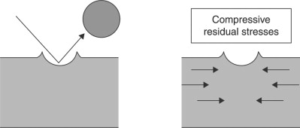
To guarantee a smooth, superior finish in vacuum chamber applications, the procedure is usually employed to release tensile tensions and produce a more uniform surface. There are the following materials used in shot peening.
- Steel: steel shots are strong, resilient, and capable of forming a consistent compressive stress layer, they are the most widely utilized material in shot peening. They are frequently used in applications like high-performance vacuum chambers that call for a stronger surface.
- Glass: Glass beads offer a smooth finish and are employed when a softer impact is required, lowering the possibility of surface damage. They are frequently employed in applications where surface quality aesthetics are crucial and are appropriate for less harsh peening.
- Ceramic: Ceramic bullets better serve applications requiring strong impact energy without contamination. Because of their superior wear resistance and non-metallic nature, they are perfect for high-precision surfaces and chambers where metal contamination must be prevented.
- Supplementary shot peening materials: To improve a component's mechanical qualities, shot peening is a method that uses additional materials, specifically for metal, iron, ceramic, composite, and plastic shots.
Shot Peening and impact on the surface
3.2 Purpose of Vacuum Chambers
Shot peening is a crucial step in vacuum chamber post-processing that improves the longevity and performance of the equipment in multiple ways:
- Enhancement of Fatigue Strength: Shot peening considerably boosts the vacuum chamber's fatigue strength by putting compressive residual strains on the surface. This prolongs the component's overall service life by reducing fatigue-related cracks and strengthening the chamber's resistance to cyclic stress.
- Reduction of Surface Imperfections: In vacuum chambers, where surface uniformity is essential for good sealing and operation, shot peening aids in smoothing out minute surface abnormalities. It increases the vacuum system's efficiency by lowering the possibility of gas leaks and entrapment.
- Avoiding Stress Corrosion Crack propagation: Stress corrosion-induced cracks are impeded in their progression by the compressive stresses generated by shot peening. This is especially important in vacuum chambers that are subjected to high pressures or hostile chemical conditions.
- Surface Hardening: By raising surface hardness, the procedure improves the chamber's ability to withstand abrasion and wear. This is crucial to ensure extended operating endurance for chambers exposed to abrasive particles or high-speed gas flows.
- Enhanced adherence for Coatings: By producing a roughened texture that facilitates improved adherence, shot peening also gets the surface ready for additional treatments like coatings or plating. This is especially crucial for chambers that need to have surface coatings applied to improve performance or provide protection.
3.3 Applications in Vacuum Chambers
Shot peening is used in a variety of vacuum chamber applications to improve the materials' resilience to environmental stress, performance, and longevity. Among the important applications are:
- High-Pressure Vacuum Chambers: Shot peening is used to strengthen resistance against fatigue and stress corrosion in chambers that are subjected to high internal pressures. This is particularly crucial in the scientific, aerospace, and automotive sectors since over time, pressure variations can cause structural deterioration.
- Vacuum Chambers in Semiconductor Manufacturing: Extremely consistent and smooth surfaces are necessary for chambers used in semiconductor production. To keep a high-precision process environment free of contaminants, shot peening aids in surface roughness reduction and chamber preparation for subsequent coatings.
- Cryogenic Vacuum Chambers: Vacuum chambers that operate in cryogenic temperatures undergo intense thermal cycling, which can cause material stress. These chambers' fatigue resistance is increased by shot peening, which helps them endure the strain brought on by abrupt temperature changes without chipping or cracking.
- Vacuum chambers with surface coatings: Shot peening primes the surface by generating a texture that is ideal for the coatings' adherence when the chambers are covered in protective layers made of titanium, ceramic, or other materials. As a result, the coating is more durable and won't flake or peel under high vacuum.
- Vacuum Chambers for Particle Accelerators: Chambers for particle accelerators frequently need to withstand high operating pressures. To guarantee the structural integrity of these chambers and lower the possibility of cracks and failures during high-energy procedures, shot peening is utilized.
- Vacuum Chambers in Nuclear Applications: Radiation and corrosive compounds are present in nuclear environments, where chambers are situated. Through increased structural robustness and resistance to corrosion, shot peening extends the service life of these chambers and guarantees safety under demanding operating circumstances.
3.4 Benefits of Shot Peening
Shot peening is a useful post-processing method that improves the performance and longevity of vacuum chambers by providing several significant benefits:
Extended Fatigue Life: Shot peening considerably boosts the fatigue strength of vacuum chambers by creating compressive residual strains on the surface. This improves the chambers' ability to tolerate cyclic loads and stops fatigue cracks from forming and spreading over time.
Enhanced Corrosion Resistance: Stress corrosion cracking is less likely to occur because of the compressive forces shot peening introduces, which stop cracks from starting and spreading. This is especially useful for vacuum chambers that are subjected to chemicals or harsh environments.
Preventing Crack Formation: Shot peening produces compressive residual stresses that help stop cracks from forming and delay the spread of pre-existing cracks. This helps prolong the life of vacuum chambers used in harsh environments.
Stress Reduction: The internal strains in the material put on by earlier production procedures like welding or machining are relieved by shot peening. By enhancing the vacuum chamber's structural integrity, this stress relief lowers the possibility of warping or failure under operational circumstances.
Cost Efficiency: Shot peening has the potential to save a substantial amount of money over time by prolonging the operating life and lowering the maintenance needs of vacuum chambers. It improves overall operational efficiency by lowering the need for replacements, repairs, and downtime.
3.5 Limitations of Shot Peening
Although shot peening is very beneficial, there are certain restrictions on how it can be used in vacuum chamber post-processing:
Possible Surface Contamination:
Material Transfer: During the shot peening procedure, there is a chance that the material will move from the peening medium to the vacuum chamber's surface. Steel shots raise unique concerns since metallic contamination might compromise the performance and cleanliness of vacuum chambers, particularly in delicate settings such as semiconductor manufacture or scientific research.
Cleaning Demands: To get rid of any pollutants, more cleaning and post-peening treatments might be required, which could make the operation more complicated and expensive.
The Suitability for Particular Materials or Geometries:
Complicated Geometries: For vacuum chambers with elaborate or complex geometries, shot peening might not be the best option. Achieving uniform covering in places with deep recesses, tight corners, or irregular shapes can be challenging and may result in inconsistent outcomes and uneven stress distribution.
Thickness Restrictions: The compressive pressures brought about by shot peening can only go down to the surface layer. This may not be effective in protecting the entire structure in thicker materials, which would limit the use of larger vacuum chamber components.
4. Sand Blasting in Vacuum Chamber Post-Processing
Sandblasting, often referred to as abrasive blasting, is a post-processing technique used in vacuum chambers that involves propelling abrasive particles against the chamber's surface at a high speed. This procedure leaves the surface clean and evenly rough, eliminating any surface impurities, rust, scale, or previous coatings.
It is crucial for surface preparation in vacuum chambers, especially before the application of coatings or treatments. Removing any particles that can interfere with the vacuum environment, improves surface cleanliness and texture, which can help vacuum systems operate better.
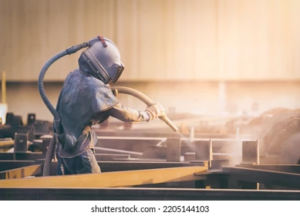
Equipment used in Sandblasting:
The following are some of the essential pieces of sandblasting equipment:
- Air Compressor: The pressurized air required to move the abrasive material at a high speed is provided by the air compressor.
- Blast Pot: A blast pot, also known as a pressure blaster, is a device that holds abrasive material and releases it into the airstream under pressure.
- Abrasive Material: Smaller objects can be shot with a blast cabinet, which is a covered work area. It contains dust and debris and recycles the abrasive material. There are categories of abrasive materials that range from metal abrasives ( steel, iron) to non-metal abrasives (Garnet, Silica sand), synthetic abrasives such as resin abrasives, plastic abrasives, and organic abrasives ( walnut shells, corn cob grit).
- Protective Gear: It shields workers from dust and abrasive materials. It consists of blast suits, gloves, helmets, respirators, and eye protection.
- Dust Collector: A filtering device used to maintain the blasting atmosphere free of dust and debris while enhancing visibility.
Abrasives Types Used:
Aluminum Oxide: It is a typical abrasive used in sandblasting, and is very strong and efficient for thorough cleaning and surface preparation. It works well for giving hard objects, such as stainless steel vacuum chambers, a smooth, clean surface.
Silicon Carbide: When a more aggressive abrasive is required, silicon carbide—which is well-known for its hardness and sharpness—is employed. It's perfect for cleaning metal vacuum chambers of oxidation, scale, and hard coatings.
Glass beads: When working with softer materials or when a smoother finish is required, glass beads offer a less harsh abrasive. They give surfaces a satin-like shine and are frequently employed in vacuum chamber preparation for decorative purposes.
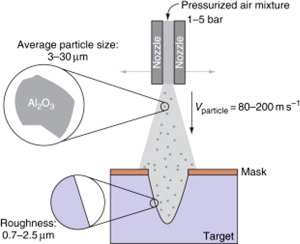
Abrasive material in sandblasting
- 4.2 Purpose in Vacuum Chambers
In vacuum chambers, sandblasting eliminates contaminants, corrosion, and prior coatings, leaving a clean surface that improves coating adhesion, such as painting or plating. It increases corrosion resistance, lessens surface tension to stop cracks, and roughens the surface to facilitate bonding.
It also removes impurities that could disrupt vacuum sealing or result in outgassing, while also leaving the chamber with a consistent, matte appearance. This procedure improves the chamber's robustness, efficiency, and dependability in difficult settings. Below is a brief overview of its main functions:
- Stress Relieving: By reducing surface tension, the abrasive material's influence on the chamber's surface lessens the chance of cracks or other flaws. This is particularly crucial for high-pressure vacuum chambers since they operate under mechanical stress.
- Enhancement of Aesthetics: Sandblasting is occasionally employed to improve the vacuum chamber's appearance. This results in a consistent, matte surface that looks tidy and expert.
- Corrosion Resistance: Sandblasting primes the surface for coatings or platings that offer corrosion resistance, which is necessary for vacuum chambers functioning in abrasive conditions.
- 4.3 Applications in Vacuum Chambers
Sandblasting is frequently used in vacuum chamber preparation and maintenance for several important reasons:
- Surface Cleaning: It makes the chamber's surface free of impurities, corrosion, and dirt, preserving a hygienic atmosphere for vacuum operations.
- Coating Preparation: Sandblasting produces a roughened surface that improves adherence to surface treatments, paint, or other future coatings.
- Resistance to Corrosion: The procedure sets the chamber for anti-corrosion coatings, prolonging the vacuum chamber's life.
- Stress Relief: Reduced risk of cracks and failures under vacuum pressure: Sandblasting assists in relieving surface tension.
- 4.4 Benefits of Sand Blasting
- More Coating Adhesion: Sandblasting produces a rougher surface, which improves the mechanical adhesion of paint, coatings, and protective layers. When vacuum chambers are used in harsh conditions, this leads to coatings that are more resilient and long-lasting.
- Remodeling: Sandblasting not only produces a consistent, matte surface but also enhances the chamber's appearance. This helps with quality control and visual inspections in particular, as well as applications where surface uniformity and cleanliness are important.
- Longer Apparatus Life: Sandblasting protects and primes the surface for protective treatments, which helps vacuum chambers last longer. Long-term chamber operation can be ensured by routine maintenance, which includes sandblasting regularly. This can help prevent wear and low repair needs.
- Versatility in Surface Texture: Sandblasting gives you exact control over the appearance of the surface, which is crucial for several uses. The method can be adjusted to fulfill different functional and design requirements, regardless of whether a smooth or rough surface is needed, enhancing both appearance and performance.
- Improved Sealing and Performance: By reducing impurities that can obstruct sealing surfaces or result in leaks, a clean, well-prepared surface helps to improve vacuum sealing. This increases the vacuum system's overall efficiency and dependability by guaranteeing that greater vacuum levels are reached and maintained.
- 4.5 Limitations of Sand Blasting
- Surface Damage: Especially on softer materials, excessive sandblasting pressure can result in unfavorable surface damage like pitting or warping. This could result in surface flaws or jeopardize the vacuum chamber's structural integrity.
- Material Erosion: Excessive use of sandblasting can cause material erosion, particularly in the vacuum chamber's delicate or thin-walled areas, shortening its lifespan or making it unfit for use in certain circumstances.
- Costly and time-consuming: Sandblasting can be costly and labor-intensive for big or complicated chambers. Post-processing may incur additional costs due to the need for specialized equipment and trained workers.
- Vulnerability to Silica Dust: When silica sand is used in traditional sandblasting, it can emit dangerous silica dust, which is extremely dangerous to breathe in. Concerns about silicosis and other respiratory conditions are frequent.
- Environmental Concerns: If sandblasting is not adequately managed, the blasting media and impurities (paint, rust, etc.) removed from surfaces may contribute to pollution in the environment. Massive sandblasting typically requires input from non-renewable sources, such as generators powered by diesel, particularly in isolated areas. Since it increases greenhouse gas emissions, this has a greater total negative environmental effect.
5. Comparison Between Shot Peening and Sand Blasting
Although shot peening and sandblasting are both surface treatment techniques frequently employed in vacuum chamber post-processing, they have different functions and ways of action. Here is a comparison between the two:
Purpose:
- Shot peening: This is a cold working technique that primarily reduces surface stress and improves the material's fatigue resistance. It produces compressive stress, which strengthens the material and lengthens its lifespan. It is intended to enhance the surface's mechanical qualities.
- Sandblasting: Mostly utilized for surface texturing, surface preparation, and cleaning. It leaves a smooth or rough surface ready for additional treatments like painting or coating by removing rust, old paint, and other impurities.
Technique:
- Shot peening is blasting small, spherical media—such as glass, ceramic, or steel beads that are bombarded at the surface at regulated speeds. The shot's repeated impact produces microscopic dimples that compress the surface and enhance the material's qualities.
- Sandblasting: To clean and roughen the surface, abrasive particles (such as sand, glass beads, or other media) are driven at high speeds. The purpose is to peel impurities, old coatings, or rust, rather than modify the material’s qualities.
Sandblasting is mostly used to prepare surfaces for coating or painting, remove rust from surfaces, and clean them. It does not provide advantageous compressive stresses, but it does improve surface adherence for treatments that come after
Surface Effect:
- Shot peening:
Shot peening reduces the risk of cracks and fatigue failure by creating a controlled dimpled surface that creates compressive stress. The surface does not become noticeably rougher.
- Sandblasting:
A rough, textured surface is produced by sandblasting, which is perfect for coating adherence but does not dramatically change the material's internal structure or stress distribution.
6. Safety Considerations and Environmental Impact
When shot peening/ blasting is used in the post-process of a vacuum chamber there are some safety considerations and environmental impacts to keep in mind. Let’s talk about it in some more detail.
1. Operator Personal Protective Equipment (PPE):
Essential personal protective equipment (PPE) consists of respirators for dust, safety goggles or face shields for debris, hearing protection for noise, and impact and abrasion-resistant clothes.
2. Retaining and Eliminating Shot Media and Abrasive Particles:
To keep dust and debris under control, utilize enclosed blasting locations. To reduce contamination, waste media must be collected and disposed of properly. Recycling or adhering to environmental rules are also essential.
3. Needs for Ventilation and Noise Control:
Install sound-absorbing enclosures, and make sure your hearing is protected. To ensure the safety and quality of the air in enclosed areas, use efficient dust collection and ventilation systems.
4. Environment challenges
Reduce dust pollution by using vacuum-assisted methods or wet blasting. Handle hazardous garbage with care, and recycle wherever you can. To lessen your impact on the environment, choose energy-efficient equipment.
7. Quality Control and Inspection after Processing
There are the following ways to maintain quality control and inspection on post-processing.
1. Techniques for Ensuring Surface Integrity Upon Treatment:
A combo of visual inspections, mechanical testing, and sophisticated procedures are used to evaluate surface integrity to confirm that there is no damage or defect created during shot peening or sandblasting.
2. Common Assessments:
The following inspections are involved in the common assessment.
● Surface Roughness Measurement:
To assess the surface texture and make sure it satisfies the necessary requirements for coating adhesion or performance, profilometers or other roughness measurement instruments are utilized.
● Residual Stress Analysis:
To verify the strengthening effects, especially after shot peening, compressive or tensile stress is checked on the treated surface using X-ray diffraction (XRD) or other stress measuring techniques.
3. Nondestructive testing (NDT) and visual inspections:
- Visual Inspections: Magnification instruments are used to identify any abnormalities, cracks, or surface problems.
- NDT: Subsurface defects can be found without causing damage to the component by using methods like dye penetrant testing, ultrasonic testing, or eddy current testing.
4. Strategies for Post-Treatment Cleaning to Prevent Contamination:
- To ensure that the surface is clear of impurities that can impair performance or coating adherence, components are cleaned using techniques including ultrasonic cleaning, solvent wiping, or air blasting after surface treatments.
8. Future Trends and Innovations
Here are some of the future trends of shot peening/sandblasting in the post-processing of a vacuum chamber. So let’s be benign.
New Developments in Sandblasting and Shot Peening Technologies:
- Enhanced control and accuracy in shot peening with the use of innovative robotics and artificial intelligence to optimize the distribution of compressive stress, resulting in improved material performance and fatigue resistance.
- High-performance sandblasting systems provide more control over the size and velocity of the abrasive media, decreasing surface damage and improving consistency in the outcomes.
Processes of Surface Treatment Automation:
- More automation and robotics are being used in shot peening and sandblasting to increase speed and safety, decrease human error, and produce consistent results in large-scale industrial applications.
- Assuring exact adherence to requirements, real-time monitoring systems are integrated to provide continuous quality control during surface treatment.
Eco-Friendly Abrasive Materials and Recovery Systems:
- Creation of environmentally friendly abrasive materials that work well for surface preparation while having a minimal negative impact on the environment, like recycled glass or biodegradable media.
- Innovative methods for recovering and recycling abrasives minimize waste and expenses by reusing and capturing media, in addition to lowering pollution and airborne pollutants.
Employing Surface Treatment in New Vacuum Chamber Technology:
- Innovative sectors like semiconductor manufacturing, space exploration, and quantum technologies use sophisticated surface treatments to improve the performance, cleanliness, and longevity of vacuum chambers.
- The utilization of nano-scale shot peening and sandblasting methods for precisely designed surfaces is essential to meet the high-performance requirements of upcoming vacuum chamber technologies.
Conclusion
In high-performance industries like aerospace and vacuum technology, shot peening and sandblasting are essential for improving material durability and surface preparedness. Then what comes next? Will automation eventually completely replace human operators in these processes, and if so, how will it affect quality control?
What can be done to push the limits of performance and environmental responsibility will determine the future of surface treatments. These procedures are becoming faster, smarter, and greener as technology advances. Innovative recovery systems are lowering waste, eco-friendly abrasives are lessening their environmental impact, and automation is simplifying processes.
Surface treatment technology has a bright future ahead of it due to advancements that should push performance and sustainability limits and enable sectors to effectively and precisely handle upcoming issues. Was this blog informative? Do you have any queries let us know by commenting below.


